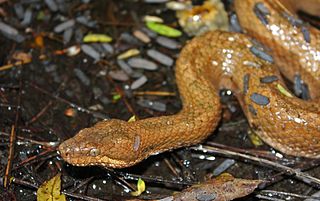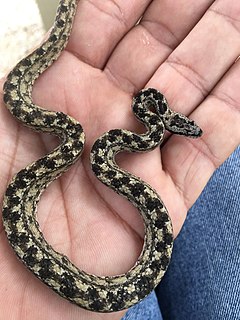
The Tropidophiidae, common name dwarf boas or thunder snakes, are a family of nonvenomous snakes found from Mexico and the West Indies south to southeastern Brazil. These are small to medium-sized fossorial snakes, some with beautiful and striking color patterns. Currently, two living genera, containing 34 species, are recognized. Two other genera were once considered to be tropidophiids but are now known to be more closely related to boids, and are classified in the subfamily Ungaliophiinae. There are a relatively large number of fossil snakes that have been described as tropidophiids, but which of these are more closely related to Tropidophis and Trachyboa and which are more closely related to Ungaliophis and Exiliboa is unknown.

Tropidophis melanurus, commonly known as dusky dwarf boa, Cuban wood snake, or Cuban giant dwarf boa, is a non-venomous dwarf boa species found mainly in Cuba. Currently, there are three subspecies recognized, including the typical form described here.

Tropidophis, common name wood snakes or West Indian wood snakes, is a genus of dwarf boas endemic to the West Indies and South America. Currently, 17 species are recognized.
Tropidophis fuscus is a non-venomous dwarf boa species found in Cuba. No subspecies are currently recognized.
Tropidophis greenwayi is a nonvenomous dwarf boa species endemic to the Caicos Islands. Two subspecies are currently recognized, including the nominate subspecies described here.

Chilabothrus angulifer, also known commonly as the Cuban boa' and the Cuban tree boa by locals as maja de Santa María, is a species of snake if the family Boidae. The species is native to Cuba and some nearby islands. There are no subspecies that are recognized as being valid.
The Bahamian pygmy boa constrictor, Inagua trope, or Bahama wood snake is a species of nonvenomous snake in the family Tropidophiidae. The species is endemic to the Great Inagua Island, the Bahamas.
Tropidophis battersbyi, also known commonly as Battersby's dwarf boa and the Ecuadorian dwarf boa, is a species of snake in the family Tropidophiidae. The species is endemic to Ecuador.

Tropidophis caymanensis, or the Cayman Islands dwarf boa, is a species of snake in the family Tropidophiidae. It is endemic to the Cayman Islands.

Tropidophis feicki, also known as the broad-banded dwarf boa or Feick's dwarf boa, is a species of snake in the family Tropidophiidae. The species is endemic to Cuba.
Tropidophis haetianus, the Haitian dwarf boa, is a species of snake in the family Tropidophiidae. It is endemic to Hispaniola in the West Indies.
Tropidophis maculatus, or the Spotted red dwarf boa, is a species of snake in the family Tropidophiidae. It is endemic to Cuba.
Tropidophis nigriventis, or the black-bellied dwarf boa, is a species of snake in the family Tropidophiidae. The species is endemic to Cuba.
Tropidophis pardalis, or the leopard dwarf boa or spotted brown trope, is a species of snake in the family Tropidophiidae. It is endemic to Cuba.
Tropidophis pilsbryi, commonly known as Pilsbry's dwarf boa or the Cuban white-necked dwarf boa, is a species of snake in the family Tropidophiidae. The species is endemic to Cuba.

Tropidophis taczanowskyi, also known commonly as Taczanowski's dwarf boa, is a species of snake in the family Tropidophiidae. The species is native to northern South America.
Typhlops capitulatus, commonly known as the Haitian pale-lipped blind snake or Richmond's worm snake, is a species of snake in the family Typhlopidae. The species is endemic to Haiti. There are no subspecies that are recognized as being valid.
The Cayman Brac blind snake is a species of snake in the family Typhlopidae.
Albert Schwartz was an American zoologist who worked extensively with the herpetofauna of Florida and the West Indies, and later with butterflies. One magazine article once dubbed him as one of the "Kings of West Indian Anole Taxonomy".






